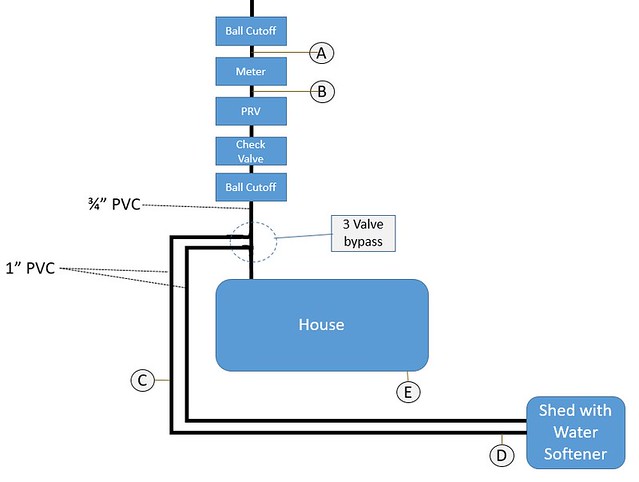stoopalini
New Member
I'm looking for assistance in trying to diagnose a 20psi pressure drop whenever a single fixture is opened. This can be a sink, an outdoor spicket, or a flushing toilet, etc ...
The house is in Texas, was built in 1998, is slab on ground, has a 3/4" PVC feed from the meter box to the house. The house then has 3/4" copper main lines with 1/2" copper branches to each fixture.
About 10 years ago, I had a water softener system installed in a small shed behind the house. To plumb it, we intercepted the water main line at the front, and created a loop. I installed three 3/4" ball valves at the intercept point, so I could bypass the softener loop if there was even an issue with it.
I made a diagram to try and help explain the issue, and what I've tried to resolve it. Points C, D and E are outdoor water spickets. C and D are on the "send side" of the softener loop. I had these installed because I wanted a couple of outdoor spickets that were not soft water. Points A and B are just points where the city took pressure measurements.

and here's a closer look at the softener bypass:

Last week, the PRV went bad and was leaking horribly. I had a plumber come out and replace it with a new Watts LF N55B M1 brass unit. I asked him to set the pressure to 70psi, which he said he did. After he left, we noticed the pressure wasn't as good as before the repair, so I bought a gauge and checked it. It was at 60psi. So I adjusted the PRV to set it to 70, and then checked with a sink flowing, and the pressure dropped to around 50psi. I then increased the PRV to 80psi, and checked again, and the pressure is dropping to 60psi when a single sink is open.
So I called the plumber and explained the issue, and he recommended I call the city. They came out to troubleshoot and took some pressure readings. At point A on my diagram, the pressure was 84/78 (84 static, 78 running). At point B, the pressure was 84/65. So they decided to replace the meter.
After the meter replacement, I still had the 20 PSI drop at the house, and the city said it must be something on my end.
To rule out the softener loop, I bypassed it by closing valves 1 and 2, and opening valve 3, to send water direct to the house. Then I took measurements at point E, and still see a 20psi drop with one sink flowing.
To rule out the house plumbing, I opened valve 1, and closed valves 2 and 3, then checked with a gauge on point C, with the spicket at point D flowing water, and I still saw the 20 psi drop.
So I called the plumber back, thinking the PRV may be bad. He pulled the PRV, the check valve, and the cutoff valve, and we inspected everything. They all seem fine, with no buildup or corrosion. So I asked him to replace the PRV anyway, which he did with a Wilkins 70XL. After the 2nd new PRV, nothing changed and I'm still experiencing a 20 psi drop when a single fixture is opened.
This makes me think there's either an issue with the city supply, or with the pipe between the meter and the 3 valve bypass, or possibly a system design issue.
The city supply is showing a 6psi drop, measure at point A. Would this translate to a 20psi drop due to distance of pipe to where I am taking measurements? The city tells me the main feed to my house is a 3/4" copper line, with a single 90 bend, then 100' of 3/4 copper pipe to a 4" main.
I've also read that a PRV needs a delta of 10psi between the incoming pressure and the outgoing pressure to function properly. So I backed the PRV down to 50psi and tested. At 50psi, the drop is no longer 20psi, but is around 10psi.
We really need a min of 60psi due to a recent master bath remodel, where we installed multiple shower heads. So to get even close to 60psi when the shower heads are in use, I've set the PRV to 80psi; but I would prefer to be able to set the PRV to something lower, like 70, if I can get the system to maintain that pressure when a fixture is in use.
I assume I didn't notice the pressure issue before this because the original PRV most likely failed a while ago, and was probably allowing full pressure to pass. I did have 3 hot water heater tank failures (internal tank ruptures) in the past 5 years. I've since replaced one tank with a tankless, and added an expansion tank to the other. These failures may be unrelated, or could be due to water pressure spikes from the city and a failed PRV not regulating the pressure.
Any help would be greatly appreciated!
The house is in Texas, was built in 1998, is slab on ground, has a 3/4" PVC feed from the meter box to the house. The house then has 3/4" copper main lines with 1/2" copper branches to each fixture.
About 10 years ago, I had a water softener system installed in a small shed behind the house. To plumb it, we intercepted the water main line at the front, and created a loop. I installed three 3/4" ball valves at the intercept point, so I could bypass the softener loop if there was even an issue with it.
I made a diagram to try and help explain the issue, and what I've tried to resolve it. Points C, D and E are outdoor water spickets. C and D are on the "send side" of the softener loop. I had these installed because I wanted a couple of outdoor spickets that were not soft water. Points A and B are just points where the city took pressure measurements.

and here's a closer look at the softener bypass:

Last week, the PRV went bad and was leaking horribly. I had a plumber come out and replace it with a new Watts LF N55B M1 brass unit. I asked him to set the pressure to 70psi, which he said he did. After he left, we noticed the pressure wasn't as good as before the repair, so I bought a gauge and checked it. It was at 60psi. So I adjusted the PRV to set it to 70, and then checked with a sink flowing, and the pressure dropped to around 50psi. I then increased the PRV to 80psi, and checked again, and the pressure is dropping to 60psi when a single sink is open.
So I called the plumber and explained the issue, and he recommended I call the city. They came out to troubleshoot and took some pressure readings. At point A on my diagram, the pressure was 84/78 (84 static, 78 running). At point B, the pressure was 84/65. So they decided to replace the meter.
After the meter replacement, I still had the 20 PSI drop at the house, and the city said it must be something on my end.
To rule out the softener loop, I bypassed it by closing valves 1 and 2, and opening valve 3, to send water direct to the house. Then I took measurements at point E, and still see a 20psi drop with one sink flowing.
To rule out the house plumbing, I opened valve 1, and closed valves 2 and 3, then checked with a gauge on point C, with the spicket at point D flowing water, and I still saw the 20 psi drop.
So I called the plumber back, thinking the PRV may be bad. He pulled the PRV, the check valve, and the cutoff valve, and we inspected everything. They all seem fine, with no buildup or corrosion. So I asked him to replace the PRV anyway, which he did with a Wilkins 70XL. After the 2nd new PRV, nothing changed and I'm still experiencing a 20 psi drop when a single fixture is opened.
This makes me think there's either an issue with the city supply, or with the pipe between the meter and the 3 valve bypass, or possibly a system design issue.
The city supply is showing a 6psi drop, measure at point A. Would this translate to a 20psi drop due to distance of pipe to where I am taking measurements? The city tells me the main feed to my house is a 3/4" copper line, with a single 90 bend, then 100' of 3/4 copper pipe to a 4" main.
I've also read that a PRV needs a delta of 10psi between the incoming pressure and the outgoing pressure to function properly. So I backed the PRV down to 50psi and tested. At 50psi, the drop is no longer 20psi, but is around 10psi.
We really need a min of 60psi due to a recent master bath remodel, where we installed multiple shower heads. So to get even close to 60psi when the shower heads are in use, I've set the PRV to 80psi; but I would prefer to be able to set the PRV to something lower, like 70, if I can get the system to maintain that pressure when a fixture is in use.
I assume I didn't notice the pressure issue before this because the original PRV most likely failed a while ago, and was probably allowing full pressure to pass. I did have 3 hot water heater tank failures (internal tank ruptures) in the past 5 years. I've since replaced one tank with a tankless, and added an expansion tank to the other. These failures may be unrelated, or could be due to water pressure spikes from the city and a failed PRV not regulating the pressure.
Any help would be greatly appreciated!
